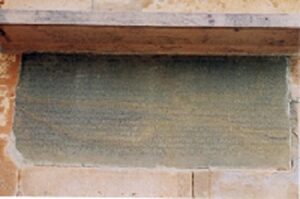The Aihole Inscription or Aihole Prashasti is a nineteen-line Sanskrit inscription found at the Meguti Jain temple in Aihole, Karnataka. It holds a significant position in South Indian (especially Karnataka) history. The Aihole Inscription was composed by the Jain poet Ravikirti in honor of his patron King Pulakesin II. Thus it is also known as Aihole Inscription of Pulakesin ll. This inscription sheds light not only on the political triumphs of Pulakesin II but also on the achievements of other contemporary rulers and dynasties.
- Location:
- History and Discovery:
- A Brief Description of Aihole Inscription:
- Some important facts mentioned in the Aihole Inscription:
- Significance of Aihole Inscription:
Location:
On the eastern side wall of the Meguti Jain Temple, we can find the Aihole Inscription. This Jain temple is located about 600m southeast of Durga temple and the archaeological museum of Aihole town. The Aihole of Karnaka (a state in South India) was the original capital of the Western Chalukyas dynasty founded in 540 CE.
History and Discovery:
The Aihole Inscription was composed by Ravikirti, a court poet of Pulakesin Satyasraya or Pulakesin II, in about 634-635 CE. Pulakesin II was the most famous ruler of the Badami Chalukya dynasty. Badami is a town in Karnataka and was formerly known as Vatapi.
Since the 1870s, the Aihole Inscription has been recorded several times. Over the years, it has been revised, republished, and retranslated by scholars like Fleet, Kielhorn, and others. In 1876, Fleet edited and published a photo-lithograph of this inscription and became the first to do so. But due to errors, it demanded a second visit to Aihole. After that, he published an improved version of the Aihole Inscription with his translation in 1879. The significance of the Aihole Inscription and the complexities of reconciling its content with other inscriptions attracted other scholars. In 1901, at Fleet’s suggestion, the Sanskrit scholar Kielhorn re-edited the inscription and published another enhanced photo-lithograph.
A Brief Description of Aihole Inscription:

This extremely valuable inscription is carved on a stone slab fixed into the wall of the Meguti temple. The inscription consists of 19 lines and covers about 4.75 feet by 2 feet surface. The height of the letters ranges from 0.5 to 0.62 inches.
The Aihole Inscription was written in the Sanskrit language and the old Kannada Chalukyan script. Out of the 19 lines, the first 17 are of Ravikirti, and the remains are added later by someone else. The Original 17 lines are all in verse and consist of a total of 37 verses. It showcases masterful uses of various classic chhandas (meters, Sanskrit prosody). Within these verses, 7 follow the standard shlokas, 2 use aupachchhandasika, 3 employ arya, 4 feature vasantatilaka, 5 present malini, and 3 embrace sardulavikridita. Furthermore, the remains are of different types of chhandas like upajati, indravaja, vamsastha, and many more.
The inscription is a prashasti that exaggerates the greatness of King Pulakesin II and the author himself. He compares the King to legends and compares himself to some great Sanskrit poets such as Kalidasa and Bharavi. Also, the author uses some phrases from Kalidasa’s Raghuvamsa and Bharavi’s Kiratarjuniya in this inscription. So, we can say that this inscription draws inspiration from these two renowned Sanskrit poets.
Some important facts mentioned in the Aihole Inscription:
The inscription says a lot about Pulakesin ll, the author, and many more about contemporary times. All the lines of the inscription have been translated in different ways by various scholars. Here, we are going to learn some of those notable facts, which are taken from the translation published by Kielhorn.
- The Aihole Inscription is open with the standard Jain salutation to Jinendra. Then marks the Chalukya family as the birthplace of jewels of men. [V 1-2]
- The Poet emphasizes the importance of acknowledging gifts and honors from the praised patron. Further, he refers to his patron as ‘Satyasraya’ i.e., ocean of truth. [V 3-4]
- The poet starts to trace the lineage of Chalukyas. He talks about King Jayasimha-vallabha and his great bravery in battles. [V 5-6]
Jayasimha was the first king of Chalukya dynasty.
- The poet mentions the King as ‘Polekesin’ and his kingdom as ‘Vatapipuri’. Also, tells about the Vedic ritual ‘Ashvamedha’ (the horse-sacrifice). [V 7-8]
These verses clear that Pulakesin is the dubbed version of modern literature and Badami is formerly known as Vatapipuri.
- King Pulakesin II was not eager for power. Finding his uncle to be jealous of him, he took a resolution to wander abroad as an exile. [V 13-14]
- The war of succession between Pulakesin II and his uncle Mangalesha is described. The poet also claims that the neighboring kingdoms saw it as an opportunity to seize parts of the Chalukya kingdom. [15-16]
- The poet refers to Lord Shiva as the ‘Destroyer of Pura’ and compares Pulakesin ll to Lord Shiva. [V 21-22]
The poetic comparisons of these and the nearby verses are taken from the great Kalidasa’s work.
- The poet exaggerates by saying that the elephants of Pulakesin II’s army exceeded the size of the Vindhya Mountains. While the Vindhya hills are impassable to them and military campaigns usually avoided that area. [V 23-24]
- Compares Pulakesin ll to the king of gods and paints him nearly as powerful as Lord Indra. The strength of his army and the virtues of his people subdued the Kalingas and Kosalas, breaking the pride of other rulers. The present state ‘Maharashtra’ is also mentioned here. [V 25-26]
- These verses highlight the notable conquest of the Pallavas by Pulakesin ll. [V 29-30]
- Pulakesin ll is compared to a hot sun melting the frost of the Pallava army. He gave homage to Gods and Brahmans. Here, also a mention of Vatapi as another name of Badami. [V 31-32]
- These verses indicate the date to be the year 3735 after the Bharata war, or Saka Samvat 556, which corresponds to 634-635 CE. [V 33-34]
This is an interpretation of Kielhorn and the most important one.
- The last two verses confirm that the Meguti Temple is a Jain mansion for the Jinas. Also, claims that it was constructed by the wise Ravikirti with the approval and assistance of the Satyasraya (Pulakesin ll). Furthermore, the poet proudly declares that his artistic talent has reached the same level of fame as Kalidasa and Bharavi. [V 35-37]
The last two lines announce the permanent donation of lands, tax revenue, and villages to support the Jain temple. Ravikirti is recognized as the benefactor who made these generous gifts. [V 38-42] (These two lines are added later and are not of Ravikirti).
** All the ‘V’ enclosed by [] refers to the word ‘Verses’.
Significance of Aihole Inscription:
The Aihole inscription holds significant historical value for understanding the Deccan and Indian history during the 6th and 7th centuries. It provides valuable information about the Meguti temple, the Chalukyas and their political achievements, and many more about that era. However, the inscription is also a subject of controversy when compared to other inscriptions outside the Badami Chalukya kingdom.
An Indologist, Richard Salomon recognizes the inscription as a useful source of certain facts. Also, he suggests that it may not be historically accurate as a court poet would probably minimize their patron’s military defeats.
Besides, being a great historical narrative, Aihole Inscription holds immense literary value. The accurate use of the rules of Sanskrit meters in the inscription indicates Ravikirti’s proficiency in the classical Sanskrit tradition.
Despite all challenges, the Aihole inscription remains valuable, providing insights into the political, cultural, and literary landscape of the time. This inscription still intrigues scholars and history enthusiasts, leaving room for further exploration and study.


